|

by Stephen Smith
April 13, 2011
from
Thunderbolts Website
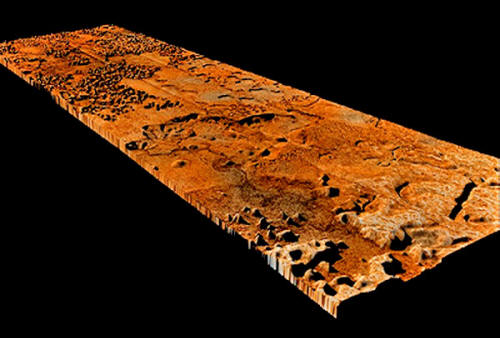
Artist impression of
Sikun Labyrinthus region on Saturn's moon Titan.
Credit: NASA/JPL/ESA/SSI and M. Malaska/B. Jonsson
Are the features found on Saturn's moon
Titan something other than they appear?
The recently renamed Cassini-Solstice spacecraft has been analyzing
information from the planet Saturn and its family of moons for
almost seven years. Its primary mission target continues to be
Titan, the largest moon in the Solar System and the only one with an
atmosphere.
Titan has
puzzled planetary scientists for as long as Cassini has
been sending data. For example, methane gas is constantly escaping
from Titan because of its low gravity. Sunlight also causes the
methane molecule to dissociate into its carbon and hydrogen
constituents.
Conventional theories state that Titan is billions of
years old, so why does a dense atmosphere continue to exist?
Cassini mission scientists believe that there are "oceans" of
methane on the surface of Titan, replenished by a "drizzle" of
liquid methane raining out of the atmosphere. Images sent from the
surface by the Huygens lander revealed a rocky landscape (below
image) with the
consistency of damp sand.
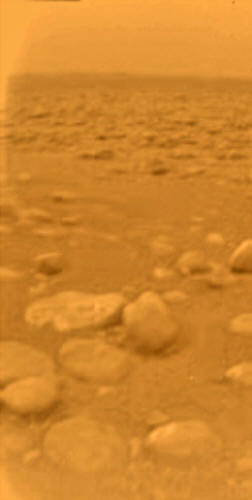
A field of small pebbles extended to the
horizon (below image.)
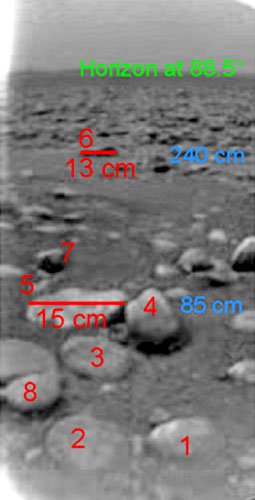
Spectrographic analysis established that the "rocks" are
made of water ice. It is easy to understand how ice can appear to be
like rock when it is at a temperature of -179° Celsius.
What Huygens did not detect was liquids
of any kind.
No methane droplets were falling from the clouds; there was no
precipitation, and no pools of methane were visible within the
lander's field of view. If there are no methane oceans to feed the
atmosphere, how is it generated?
Cassini team members speculated for some time that so-called "cryo-volcanoes"
were keeping Titan's atmosphere replenished. These supercooled
eruptions were thought to bring the necessary gases out from the
interior as Titan is heated up while being squeezed and twisted by
Saturn's tidal forces.
Recent data from Cassini has dispelled that
notion, however.
Titan retains its atmosphere because it is a relative newcomer to
the Solar System born from Saturn in an electrical conflagration.
Saturn contains a great deal of methane in its atmosphere, so if
Titan came into existence just a few thousand years ago, it has not
had time to lose what it was born with.
A
previous Picture of the Day noted that
flowing methane (or ethane)
has never been found on Titan and that the entire line of reasoning
follows from an assumption without foundation.
The so-called “river valleys” on Titan
do not look as if they were carved-out by flowing liquids. Electric
Universe advocates
predicted that an examination of the images would
reveal the "rilles" going uphill and downhill, rather than always
downhill, as a moving stream would do. Rather, what we see on Titan
are probably electric discharge effects.
"Sinuous rilles" occur on most rocky planets and moons. Although
they superficially resemble some river systems on Earth, there are
no catchment areas or feeder streams and the tributaries are short,
often meeting the main channel at right angles, a sign of electric
arcs traveling through the terrain. Also, rather than ocean basins,
the flat depressions on Titan could have been etched out by
energetic plasma discharge events.
Titan is an electrically charged body that is constantly bombarded
by ion storms from Saturn. It has a particle fountain flowing out of
its poles, as well as a torus of charged particles encircling it.

The banding around its north pole
(above image) indicates that streams of charged particles are circling Titan in
the same way that electrons and positive ions circle Earth in
opposite directions.
In other words, there is a plasma ring
surrounding Titan that influences its geology and its weather.
Orbital images confirm that it has a dry surface where dunes several
meters high march across the terrain in parallel rows. The so-called
"dunes" are large, being visible from the Cassini orbiter thousands
of kilometers away. They are quite distinct, with well-defined,
almost solid-looking ripples and waves that pass over craters and
around "yardangs."
They appear to follow wind patterns, but
they also have some characteristics (below image) that might mean they are not
wind-generated in the conventional sense.
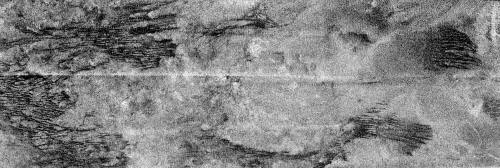
Many of the dunes look
like fingerprint patterns (below image), with whorls and arches.
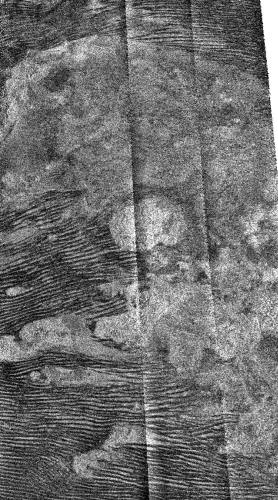
In response to the reported "anomalies" found on Titan,
Electric
Universe theorist Wal Thornhill
wrote:
"Huygens' descent to Titan's surface
was an acid test... In particular, the expectation of channels
carved by cosmic lightning, similar to Venus, was confirmed. The
channels on Titan bear the hallmarks of cosmic lightning
imprinted on the surface.
Also, the lack of a methane ocean
was predicted because Titan's atmosphere is very young and a
vast reservoir of the gas is not needed to make good the losses
expected over the 4.7 billion years required by the solar nebula
model.
Titan is a Rosetta Stone for
planetary history once the context is understood... Titan's
surface - and the other bodies in the solar system - can be
deciphered when it's realized they repeat what is 'said' in
plasma discharges."
|






